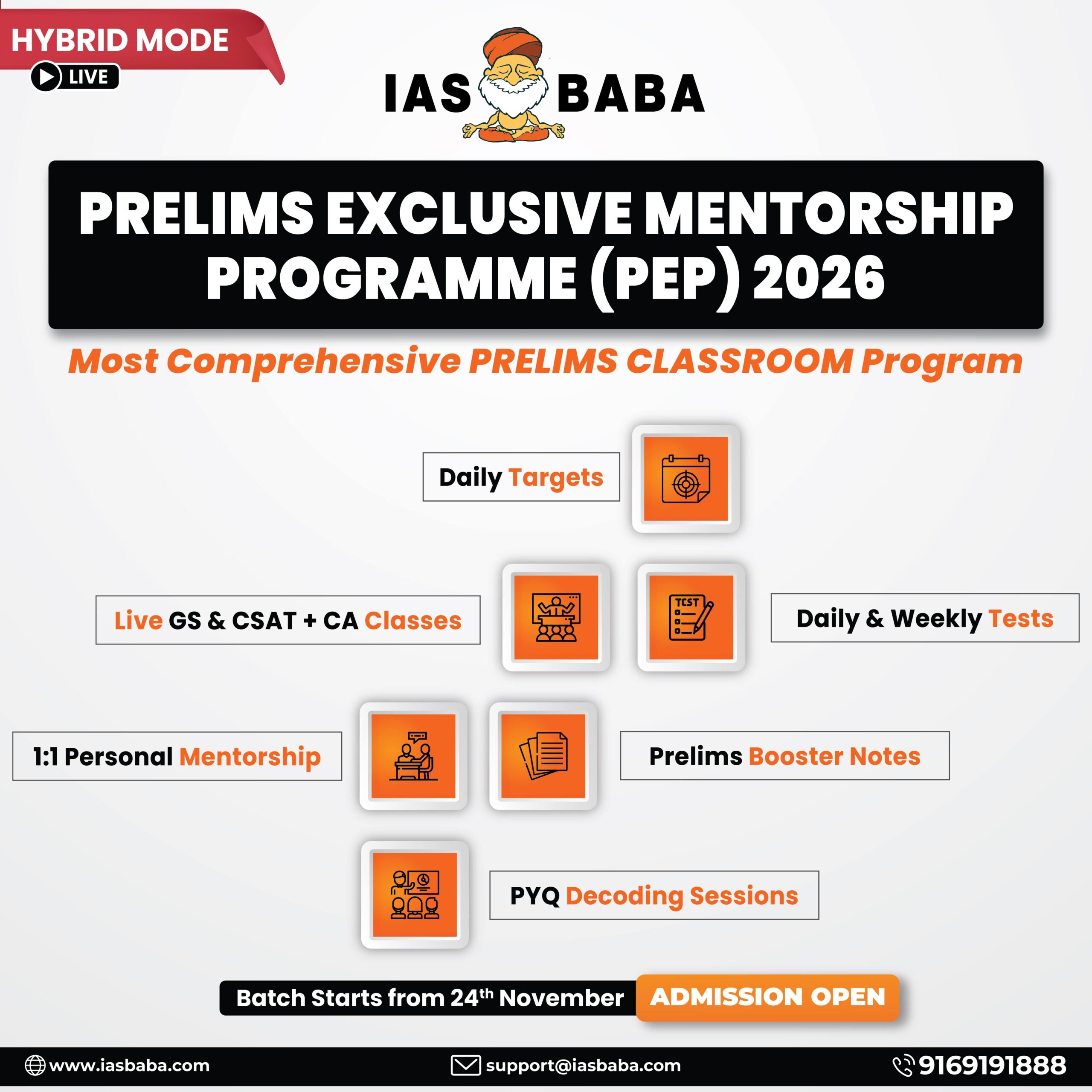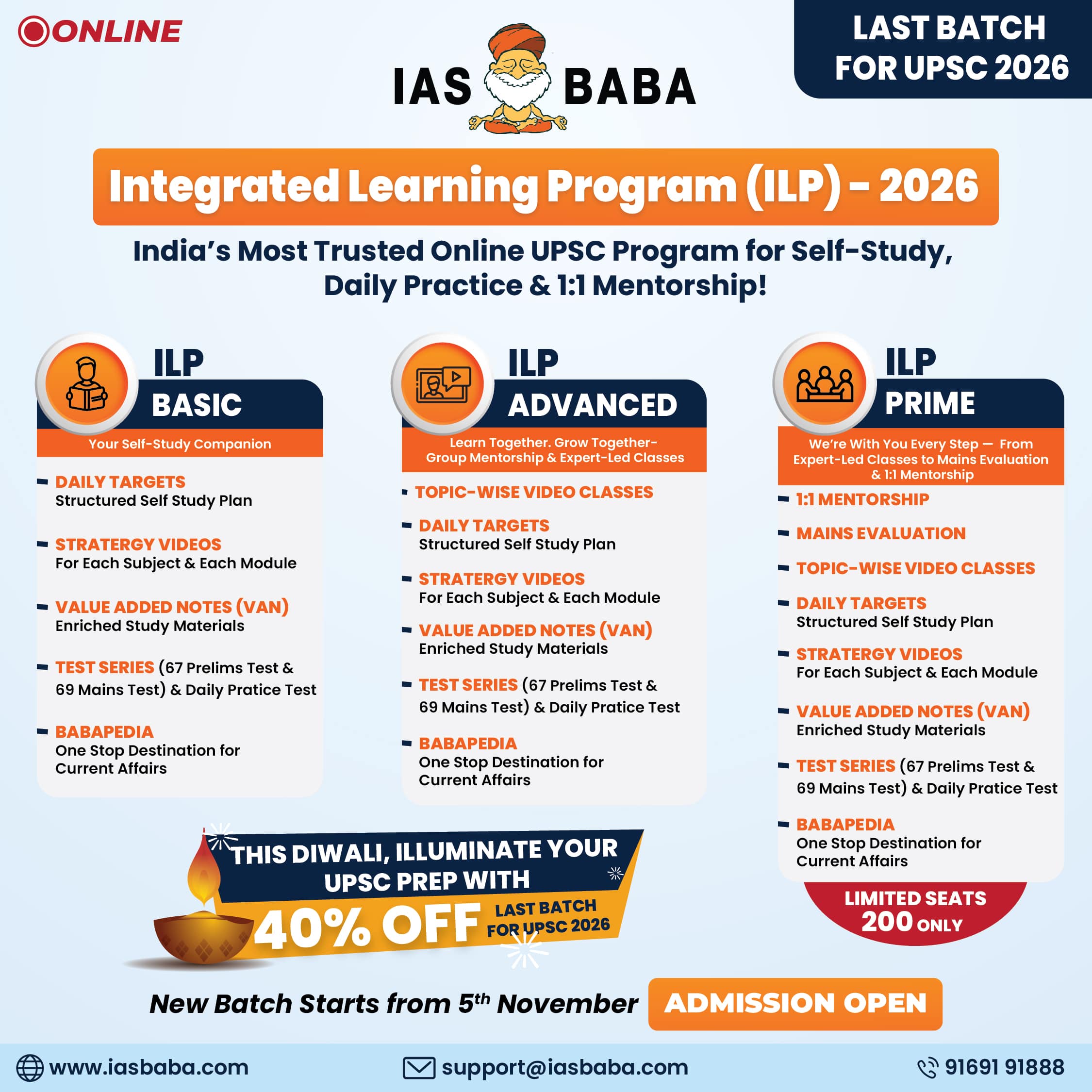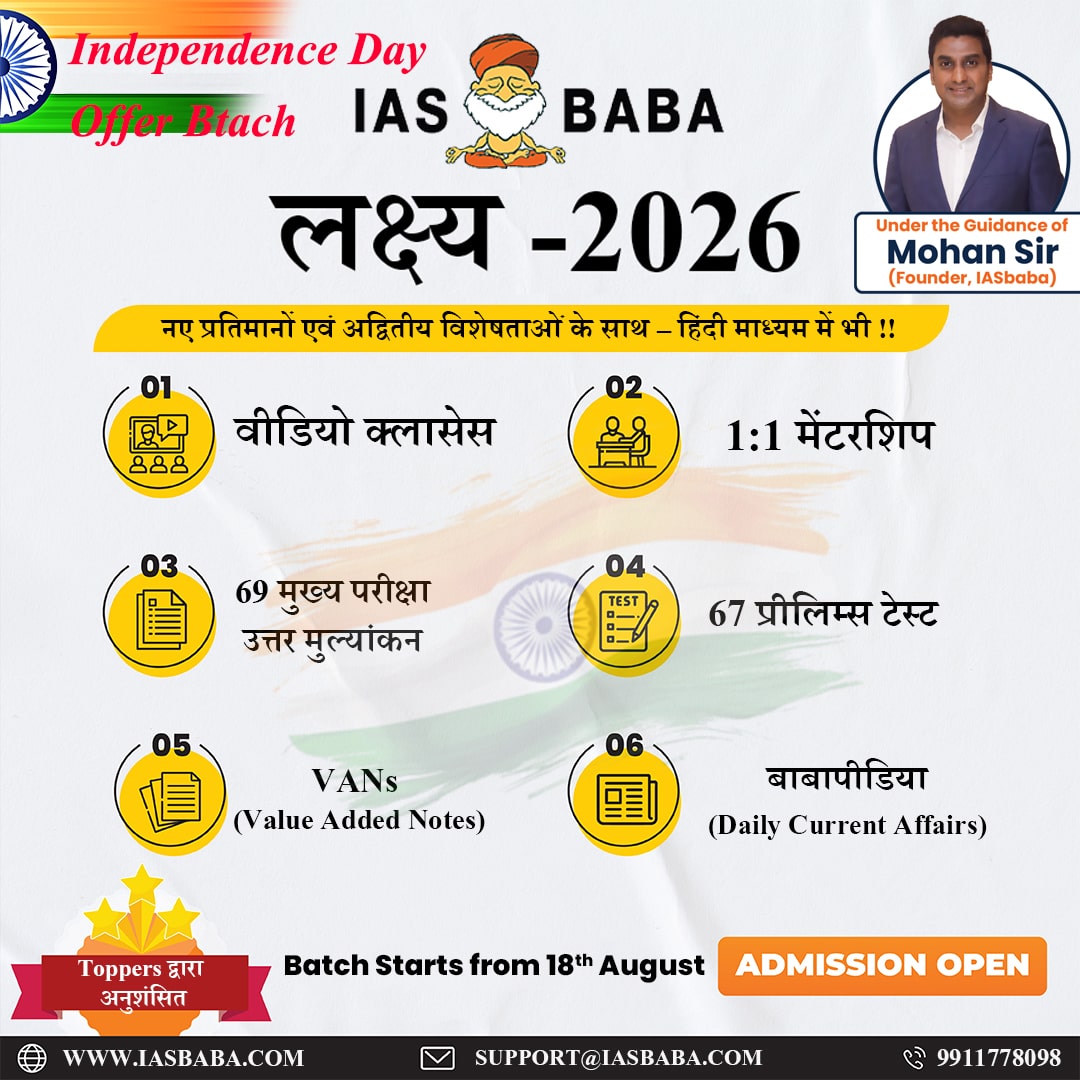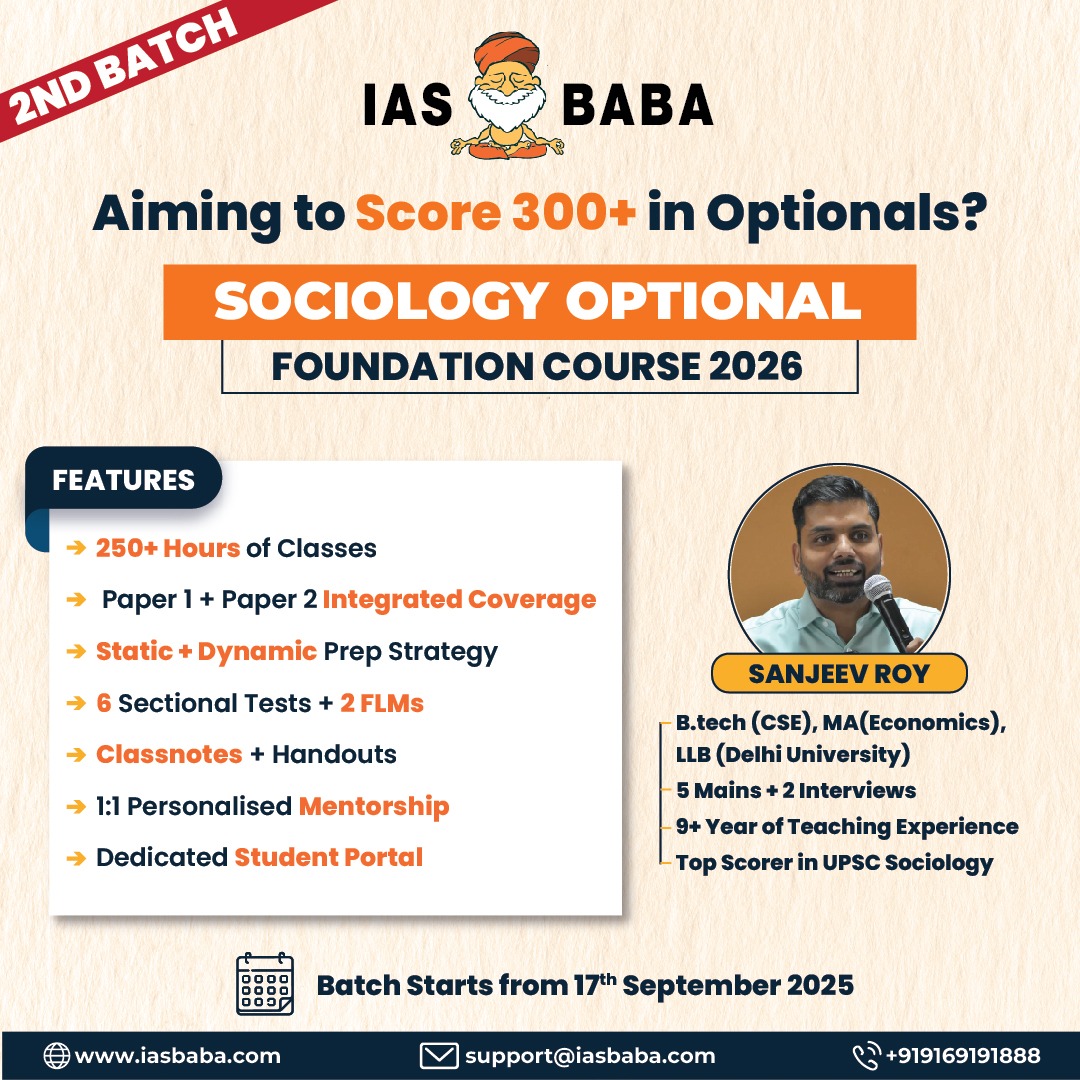IASbaba's Daily Current Affairs Analysis
Archives
(PRELIMS Focus)
Category: INTERNATIONAL
Context: Israel has launched its most extensive military operation in recent history, striking Iran’s key nuclear and military facilities
Decoding Context:
The attack primarily targeted the Natanz uranium enrichment facility, missile bases, and research centers, killing several top Iranian officials
Key Highlights:
- The attack followed a critical IAEA resolution against Iran for non-compliance with nuclear safeguards.
- Prime Minister Netanyahu described the strike as a “pre-emptive action” to stop Iran from acquiring nuclear weapons.
- Major sites targeted included Natanz, Isfahan, Tehran, Tabriz, Kermanshah, Badrak, Piranshahr, and Sardasht.
- Despite the severity, experts believe the risk of a radiation leak is low due to the type of uranium involved and the design of the facility.
Implications:
- Marks a sharp escalation in Israel-Iran tensions.
- Likely to impact ongoing nuclear negotiations and regional stability.
- Iran’s response and the global diplomatic fallout remain uncertain.
Learning Corner:
Brief Note on the Israel-Iran Conflict
The Israel-Iran conflict is a long-standing geopolitical rivalry marked by deep ideological, strategic, and security tensions in the Middle East.
Historical Background:
- After the 1979 Islamic Revolution, Iran adopted a strongly anti-Israel stance, calling for the elimination of the Israeli state.
- Iran supports militant groups like Hezbollah (Lebanon) and Hamas (Gaza), which oppose Israel.
- Israel views Iran’s regional influence and proxy network as a direct threat to its security.
Key Issues:
- Nuclear Program:
- Iran’s pursuit of nuclear technology has been a central point of contention.
- Israel considers a nuclear-armed Iran an existential threat and has conducted cyberattacks (e.g., Stuxnet) and targeted killings of Iranian nuclear scientists.
- Recent years have seen direct military actions by Israel against Iranian nuclear sites and facilities.
- Proxy Warfare:
- Iran supports armed groups across the region (Syria, Lebanon, Gaza, Iraq, Yemen), which Israel frequently targets through airstrikes.
- The conflict often manifests indirectly through these proxies, especially on Israel’s northern and southern borders.
- Recent Escalations (2024–2025):
- Israel has intensified strikes against Iranian military assets and nuclear sites inside Iran.
- Iran has retaliated with missile and drone attacks.
- These direct confrontations mark a dangerous shift from shadow warfare to open military engagement.
Global Implications:
- Regional Instability: The conflict threatens to destabilize the broader Middle East.
- Energy Security: Disruption in the Strait of Hormuz or oil infrastructure can impact global markets.
- Nuclear Non-Proliferation: The breakdown of diplomatic efforts (e.g., JCPOA) risks a nuclear arms race in the region.
Source : THE HINDU
Category: ECONOMICS
Context: The Reserve Bank of India’s final directions on gold loans are seen as a growth driver for NBFCs, especially those focused on small-ticket lending.
Key Highlights:
- Higher LTV Ceiling:
The loan-to-value (LTV) ratio has been raised to 85% for loans up to ₹2.5 lakh, up from 75%, benefiting NBFCs whose portfolios mostly comprise small-ticket gold loans. - Bullet Repayment Loans:
For bullet loans (where interest and principal are repaid together), the LTV must now be calculated including accrued interest, not just principal. The increased LTV helps offset this stricter computation. - Risk Management Emphasis:
While higher LTV allows greater lending, it also increases exposure to gold price volatility. Timely auctions and robust risk practices are now more critical. - No Extra Provisioning:
The proposed 1% additional provisioning for LTV breaches has been dropped. However, NBFCs must clearly outline their response and auction policies for LTV breaches. - Uniform Rules and Timeline:
These rules apply to all regulated lenders (including banks) and will be implemented from April 1, 2026, giving NBFCs time to adjust. - Crisil’s View:
The new framework provides additional lending flexibility and regulatory clarity, supporting growth while intensifying competition.
Learning Corner:
Monetary Policy Measures by RBI
The Reserve Bank of India (RBI) uses monetary policy tools to regulate money supply, control inflation, ensure financial stability, and support economic growth. These tools are broadly classified into:
- Quantitative Measures (General Instruments)
These control the overall money supply and credit volume in the economy.
| Measure | Description |
|---|---|
| Cash Reserve Ratio (CRR) | Percentage of a bank’s total deposits that must be kept with RBI as reserves. Higher CRR reduces lending capacity. |
| Statutory Liquidity Ratio (SLR) | Percentage of net demand and time liabilities (NDTL) that banks must maintain in the form of liquid assets (like government securities). |
| Repo Rate | Interest rate at which RBI lends to banks. A higher repo rate makes borrowing costly, reducing money supply. |
| Reverse Repo Rate | Interest rate at which RBI borrows from banks. Used to absorb excess liquidity. |
| Bank Rate | Long-term lending rate of RBI to banks. Rarely used now. |
| Open Market Operations (OMO) | RBI buys/sells government securities in the open market to control liquidity. Buying increases money supply; selling reduces it. |
- Qualitative Measures (Selective Instruments)
These focus on controlling the use or direction of credit rather than its volume.
| Measure | Description |
|---|---|
| Credit Rationing | RBI imposes limits on loans to certain sectors or businesses. |
| Moral Suasion | RBI persuades banks (non-binding) to follow certain credit practices, like not lending excessively to speculative sectors. |
| Selective Credit Controls | RBI restricts lending for certain purposes like hoarding or speculative trading. |
| Margin Requirements | RBI sets minimum margin for loans against securities to control speculative credit. |
Source: THE HINDU
Category: HISTORY
Context : The Keezhadi archaeological site in Tamil Nadu has become the center of a political and academic controversy.
Decoding Context:
Keezhadi Excavation
Located near the Vaigai river, the site has revealed the remains of an advanced urban civilization dating back to at least the 6th century BCE. Artifacts such as pottery, tools, and graffiti resembling the Indus script point to a literate, secular, and technologically advanced Tamil society.
Political and Academic Tensions
- The excavation, initiated in 2015, was led in early phases by archaeologist K. Amarnath Ramakrishna. He has refused to revise his 982-page report, asserting it is scientifically valid.
- The Archaeological Survey of India (ASI) and Union Culture Ministry have asked for revisions, citing lack of scientific rigor.
- Tamil Nadu leaders and scholars allege political interference by the central government, accusing it of trying to suppress evidence that showcases the antiquity and independence of Tamil civilization—one that challenges dominant Hindutva narratives.
- The transfer of the lead archaeologist and delays in approval and funding are seen as deliberate stalling tactics.
Statements and Reactions
- Chief Minister M.K. Stalin has accused the Centre of undermining Tamil heritage.
- Union Minister Gajendra Singh Shekhawat denied any political motive, stating more scientific validation is required.
- Tamil academics argue there is a double standard, with less scrutiny applied to excavation reports from Ayodhya and Mathura.
Learning Corner:
Note on Keezhadi Excavation
Keezhadi is an archaeological site located near the Vaigai River in Sivaganga district, Tamil Nadu. Excavations at the site, which began in 2015, have uncovered evidence of an urban, literate, and advanced civilization dating back to 6th century BCE, contemporaneous with the later phase of the Indus Valley Civilization.
Key Findings:
- Pottery with graffiti symbols, some resembling the Indus script.
- Well-planned settlements, brick structures, and drainage systems.
- Evidence of agriculture, trade, craft production, and literacy.
- Artefacts suggest a secular, Dravidian civilization with rich cultural development.
Significance:
- Indicates that urban civilization existed in southern India earlier than previously believed.
- Suggests cultural continuity between the Indus Valley and ancient Tamil societies.
- Challenges earlier notions that South India remained primitive during the early historic period.
Source : THE INDIAN EXPRESS
Category: POLITY
Context : Karnataka Chief Minister Siddaramaiah has raised serious concerns over the state’s inadequate fiscal returns from the central tax pool.
Decoding Context
Although Karnataka contributes nearly 8.7% of India’s GDP and ranks second in GST collections, it receives only 15 paise per rupee contributed to Union taxes.
He pointed out that:
- Karnataka’s share dropped from 4.71% to 3.64% under the 15th Finance Commission, leading to a loss of over ₹80,000 crore.
- The state’s per capita devolution fell from 95% to 73% of the national average between the 14th and 15th Commissions.
Key Demands to the 16th Finance Commission:
- Raise vertical devolution (share of taxes to states) to at least 50%.
- Cap cesses and surcharges at 5%, and include excess amounts in the divisible pool.
- Include Union non-tax revenues in the divisible pool.
- Limit Centre’s discretionary grants to 0.3% of total devolution.
- Allocate ₹1.15 lakh crore for Bengaluru’s infrastructure development.
The CM emphasized that reforms in tax devolution are essential for fairness and to sustain high-performing states like Karnataka, warning that continued imbalance could hurt national economic progress.
Learning Corner:
Note on Fiscal Federalism in India
Fiscal federalism refers to the division of financial powers and responsibilities between the Union and the States. In India, it is grounded in the Constitution and reflects the country’s quasi-federal structure.
Key Features:
- Division of Taxes:
- The Union List and State List define tax powers.
- The Centre collects taxes like income tax, corporate tax, GST, etc.
- States collect taxes like state GST, excise on alcohol, property tax, etc.
- Devolution of Resources:
- A Finance Commission is constituted every 5 years (Article 280) to recommend the distribution of net tax proceeds between the Centre and the States (vertical devolution) and among states (horizontal devolution).
- Grants-in-Aid (Article 275):
- Centre provides both statutory and discretionary grants to states for development and deficit correction.
- Borrowing Powers:
- States can borrow only within limits set by the Centre under Article 293.
- Recent Trends:
- Greater use of cesses and surcharges, which are not shared with states, has led to concerns about shrinking divisible pool.
- States demand more fiscal autonomy and transparency in fund allocation.
Source: THE INDIAN EXPRESS
Category: POLITY
Context : The 17th edition of the India-Mongolia joint military exercise “Nomadic Elephant” concluded on June 13, 2025, in Ulaanbaatar, Mongolia
Decoding Context:
Key Highlights:
- The Indian Army contingent, comprising 45 personnel mainly from the Arunachal Scouts, participated in the exercise.
- The joint training emphasized interoperability in semi-conventional operations under a UN mandate, especially in semi-urban and mountainous terrain.
- Activities included:
- Counter-insurgency and counter-terrorism operations
- Endurance and reflex shooting
- Room intervention and small team tactics
- Rock craft training
- Cyber warfare modules
Significance:
- Strengthens bilateral defence cooperation and trust between India and Mongolia.
- Reinforces shared interests in regional stability, international peacekeeping, and strategic partnership.
- Enhances the Indian Army’s readiness for multinational missions in varied terrain.
Learning Corner:
Major Military Exercises Involving India
| Exercise Name | Partner Country/Group | Type | Branch Involved | Focus/Remarks |
|---|---|---|---|---|
| Yudh Abhyas | United States | Bilateral | Army | Counter-insurgency and interoperability |
| Tiger Triumph | United States | Bilateral | Tri-services | Amphibious operations |
| Cope India | United States | Bilateral | Air Force | Air combat training |
| MALABAR | US, Japan, Australia | Multilateral | Navy | Indo-Pacific security and naval cooperation |
| INDRA | Russia | Bilateral | Tri-services | Strategic cooperation, anti-terror ops |
| Garuda | France | Bilateral | Air Force | Air warfare training |
| Varuna | France | Bilateral | Navy | Maritime security and coordination |
| Shakti | France | Bilateral | Army | Counter-terrorism and tactical ops |
| Ajeya Warrior | United Kingdom | Bilateral | Army | Counter-insurgency operations |
| Konkan | United Kingdom | Bilateral | Navy | Maritime operations |
| Indra Dhanush | United Kingdom | Bilateral | Air Force | Air combat tactics |
| AUSINDEX | Australia | Bilateral | Navy | Maritime interoperability |
| AUSTRA HIND | Australia | Bilateral | Army | Peacekeeping and HADR |
| JIMEX | Japan | Bilateral | Navy | Maritime security and interoperability |
| Dharma Guardian | Japan | Bilateral | Army | Counter-insurgency |
| Surya Kiran | Nepal | Bilateral | Army | Jungle warfare and mountain ops |
| Sampriti | Bangladesh | Bilateral | Army | Counter-terrorism |
| Bongosagar | Bangladesh | Bilateral | Navy | Maritime cooperation |
| Mitra Shakti | Sri Lanka | Bilateral | Army | Counter-terrorism and HADR |
| SLINEX | Sri Lanka | Bilateral | Navy | Maritime cooperation |
| Ekuverin | Maldives | Bilateral | Army | Counter-insurgency |
| Maitree | Thailand | Bilateral | Army | Jungle warfare and disaster response |
| VINBAX | Vietnam | Bilateral | Army | United Nations peacekeeping training |
| Nomadic Elephant | Mongolia | Bilateral | Army | Counter-insurgency in mountainous terrain |
| RIMPAC | US-led Multinational | Multilateral | Navy | World’s largest naval exercise |
| MILAN | Multinational (hosted by India) | Multilateral | Navy | Naval diplomacy and cooperation |
| SCO Peace Mission | SCO Members (incl. China, Russia) | Multilateral | Army | Anti-terror and joint ops training |
| Cobra Gold | Thailand + Indo-Pacific partners | Multilateral (Observer) | Army/Navy | Humanitarian and military cooperation |
Source: PIB
(MAINS Focus)
Introduction (Context)
The United Nations Population Fund (UNFPA) has released its State of the World Population Report 2025, which focuses on “Real fertility crises: The pursuit of reproductive agency in a changing world”. As fertility rates decline worldwide, the crisis lies not in population numbers but in unmet reproductive aspirations of women and couples.
In India, even as the fertility rate declines, significant challenges remain regarding reproductive autonomy, access to fertility care, and freedom to make informed family planning decisions.
What is Fertility Rate?
- Fertility Rate (Total Fertility Rate – TFR) is the average number of children a woman is expected to have during her reproductive years (usually 15–49), assuming current age-specific fertility rates remain constant.
- Replacement-level fertility: A TFR of 2.1, which allows a population to exactly replace itself from one generation to the next without migration.
Fertility Rate of India
- TFR declined from 2.9 (2005) to 2.0 (2020) (SRS).
- Population of children under five peaked in 2004, and under 15 peaked in 2009.
- Despite the decline, inter-state variations persist e.g., Bihar >3.0 vs Kerala <1.8.
What are Reproductive Rights?
Reproductive rights include:
- The right to access contraception and fertility care.
- The right to safe and legal abortion.
- The right to access maternal and sexual healthcare.
- The freedom to make decisions about reproduction without coercion, violence, or discrimination.
- The right to privacy and dignity in reproductive choices.
Key Findings of UNFPA Report 2025:
- Global fertility decline from 5 (1960) to 2.2 (2024); many countries now below replacement level (2.1).
- Many individuals face obstacles both in avoiding unintended pregnancies and in having children when they want to. In India, over 36 per cent of respondents reported an unintended pregnancy, while over 30 per cent were unable to have a child when they wished to.
- This reflects a dual challenge: Underachieved fertility, where people have fewer children than desired, and overachieved fertility, where they have more children than they intended. National data from NFHS-5 underscores this, with 9.4 per cent of currently married women aged 15–49 reporting an unmet need for family planning. .
Issues in Reproductive Autonomy
1. Infertility Crisis:
- High stigma around childlessness.
- For couples struggling with infertility, the options are often limited, expensive, or poorly regulated. Treatments are dominated by private players, and high costs, combined with lack of insurance coverage, make the experience prohibitively expensive for most.
2. Skewed Contraception:
- Reliance on female sterilisation (66% of modern method users).
- Low usage of reversible methods like IUDs, pills, condoms.
- Myths and gender bias in contraceptive access.
- Despite advances in healthcare, many women still face barriers in accessing maternal care and reproductive health information.
3. Gendered Burden of Marriage:
- Women still disproportionately manage domestic, caregiving, and child-rearing.
- Delayed childbearing among the educated, but lack of support for second child planning.
- Early childbearing is on the decline, with more women choosing to have children later in life (World Fertility Report, 2024).
- In India, many educated, working individuals from higher income groups are marrying in their late 20s or early 30s and having their first child soon after. However, when it comes to a second child, spacing practices critical for maternal, child and societal health are overlooked.
4. Workplace Constraints:
- No universal paid parental leave or workplace childcare in India.
- Women in informal sector have zero protection.
- Pregnancy-related discrimination common.
Value Addition:
Key Judicial Judgments for reproductive rights of women
-
Suchita Srivastava v. Chandigarh Administration (2009):
-
- Recognised a woman’s right to make reproductive choices as a dimension of personal liberty under Article 21.
- Asserted consent of the woman as central to abortion decisions.
-
K.S. Puttaswamy v. Union of India (2017):
-
- Recognized right to privacy as a fundamental right.
- Reproductive autonomy is protected under this ruling.
-
X v. Principal Secretary Health (2022):
-
- Allowed an unmarried woman to access abortion beyond 20 weeks.
- Stressed the need to treat married and unmarried women equally under reproductive laws.
Terminologies
- Crude Birth Rate (CBR): Number of live births per 1,000 population per year.
- General Fertility Rate (GFR): Number of live births per 1,000 women of reproductive age (15–49 years).
- Total Fertility Rate (TFR): Average number of children a woman would have in her lifetime based on current age-specific fertility rates.
- Underachieved Fertility: Situation where individuals or couples have fewer children than they desire.
- Overachieved Fertility: Situation where individuals or couples have more children than they intended or planned.
- Unmet Need for Family Planning: When a woman wants to delay or stop childbearing but is not using any form of contraception.
- Infertility: Inability to conceive after 12 months of regular, unprotected sexual intercourse.
Way forward
- Focus on rights-based, choice-centered family planning.
- Move beyond “population control” to reproductive justice.
- Integrate infertility treatment, contraceptive counselling, and maternal health in public healthcare.
- Ensure reliable and affordable access to modern contraception.
- Mass campaigns to dismantle stigma around contraception, infertility, and child spacing.
- Promote male responsibility in fertility choices.
- Enforce workplace reforms: parental leave, flexible hours, and universal childcare.
- Incentivise family-friendly work culture and balanced gender roles.
Conclusion
This is the right time to take active steps to involve women, families, and communities in making informed decisions about their reproductive choices. Instead of trying to control how many children people have, we should focus on supporting their personal choices. India needs to be ready to understand and adjust to changes in population by respecting people’s rights. If we make reproductive health policies that respect people’s wishes, we can build a strong, fair, and dignified future for everyone.
Mains Practice Question
Q “India’s fertility crisis is more about enabling informed reproductive choices than declining birth rates.” Critically examine in the context of the UNFPA 2025 Report findings. (250 words, 15 marks)
Introduction (Context)
India’s agriculture sector is witnessing a paradigm shift with the integration of digital technologies such as Artificial Intelligence (AI), remote sensing, and data analytics. The recent launch of CROPIC (Collection of Real Time Observations & Photo of Crops) by the Ministry of Agriculture exemplifies how AI is being harnessed for improving crop monitoring, insurance delivery, and policy response.
AI and Agriculture
- Artificial Intelligence in agriculture involves the use of algorithms, machine learning, and computer vision to interpret data and aid decision-making across various agricultural operations.
- It helps in predicting weather patterns, detecting crop diseases and automating farm operations
- AI offers solutions to long-standing challenges like low productivity, post-harvest losses, and inadequate insurance mechanisms.
Applications of AI in Agriculture
1. Crop Monitoring and Health Assessment
- AI uses satellite images and drone-captured data to detect crop stress, pest attacks, and nutrient deficiencies.
- Helps in timely intervention and improves yield quality and quantity.
2. Precision Farming
- AI-based tools optimise the use of water, fertilisers, and pesticides by analysing soil health and crop needs.
- Reduces input costs and environmental impact.
3. Weather Forecasting and Advisory
- AI models analyse climate data to give location-specific weather forecasts.
- Supports farmers in planning sowing, harvesting, and irrigation schedules.
4. Yield Prediction
- AI algorithms predict crop yields based on weather, soil, and historical data.
- Aids government and private players in planning procurement and supply chain logistics.
5. Pest and Disease Detection
- AI tools identify crop diseases and pests through image recognition.
- Early diagnosis prevents spread and reduces losses.
6. Smart Advisory Services
- Chatbots and voice-based assistants provide customised farming advice in local languages.
- Useful for illiterate and smallholder farmers.
7. Crop Insurance and Loss Assessment
- AI analyses field photos to automate crop loss verification.
- Speeds up insurance claim settlement and reduces disputes.
8. Post-Harvest Management and Supply Chain
- AI helps optimise storage, transport, and market linkages.
- Reduces wastage and ensures better price realisation for farmers.
9. Farm Automation
- AI-powered machines and robots assist in sowing, weeding, and harvesting.
- Reduces labour dependency and increases efficiency.
Example: CROPIC
- CROPIC stands for Collection of Real Time Observations & Photo of Crops.
- Under this crops will be photographed four-five times during their cycle, and the pictures will be analysed to assess their health and potential mid-season losses.
- The study will be carried out for two seasons initially, kharif 2025 and rabi 2025-26.
- The study envisages collection of field photographs during the crop season using a mobile application.
- The CROPIC mobile app has been developed by the Union Ministry of Agriculture and Farmers’ Welfare.
- The photographs from the field will be crowd-sourced directly from farmers. Then, they will be analysed for information including crop type, crop stage, crop damage and its extent.
- The CROPIC model will use an AI-based cloud platform for photo analysis and information extraction, and a web-based dashboard for visualisation.
- Also, when compensation or insurance is to be paid to farmers, officials will collect the photographs using the CROPIC Mobile App.
- Hence, will help in reducing subjective errors in crop loss assessment and enables faster and fairer claim settlements for farmers.
Challenges in Implementing AI in Indian Agriculture
AI integration in Indian agriculture faces several structural and socio-economic challenges:
- Digital Divide: Small and marginal farmers, who make up the majority, often lack access to smartphones, internet, and digital literacy needed to use AI-based tools like CROPIC.
- Data Gaps and Quality Issues: AI requires large volumes of accurate, real-time data. Poor data collection methods, inconsistent crop tagging, and lack of field validation can affect the reliability of AI outputs.
- High Initial Costs: Although long-term savings are possible, the upfront cost of AI tools and services remains a barrier for many farmers.
- Bias and Regional Inaccuracy: AI models trained on limited datasets may fail to capture India’s agro-climatic diversity, leading to inaccurate predictions or exclusions.
- Privacy and Consent: Concerns about the ownership and ethical use of farmer data are growing. Clear regulations on data protection are still evolving.
- Infrastructure Bottlenecks: Patchy mobile networks, lack of rural cloud infrastructure, and insufficient local-language interfaces hinder large-scale adoption.
Way Forward
To make AI a farmer-centric, inclusive tool, India must adopt a multi-pronged approach:
- Strengthen Rural Connectivity: Ensure reliable mobile internet in rural and remote areas to support digital agriculture platforms.
- Build Local AI Models: Develop region-specific, open-source AI datasets and tools in local languages to improve usability and accuracy.
- Enhance Farmer Training: Integrate digital literacy and AI training in Krishi Vigyan Kendras (KVKs) and through FPOs.
- Promote Public-Private Collaboration: Leverage expertise from startups, agri-tech firms, and research institutions for innovation and scalability.
- Ensure Ethical Governance: Create a robust data privacy framework that empowers farmers to control and benefit from their data.
- Scale Pilot Projects: Expand successful models like CROPIC across agro-climatic zones to create a unified digital agricultural ecosystem.
Conclusion
CROPIC represents a major step towards data-driven, AI-supported agriculture in India. By digitising agriculture in India, efficiencycan be achieved. However, to realise its full potential, inclusive digital access, localised AI training, and strong institutional support are crucial.
Mains Practice Question
Q “Artificial Intelligence can transform agriculture in India by making it more precise, resilient, and data-driven. However, it is not free from challenges.” Discuss with reference to the CROPIC initiative. (250 words, 15 marks)
Daily Practice MCQs
Today’s – Daily Practice MCQs’ will be updated in our “Daily Current Affairs Quiz” section on our website
Please click on the below link













